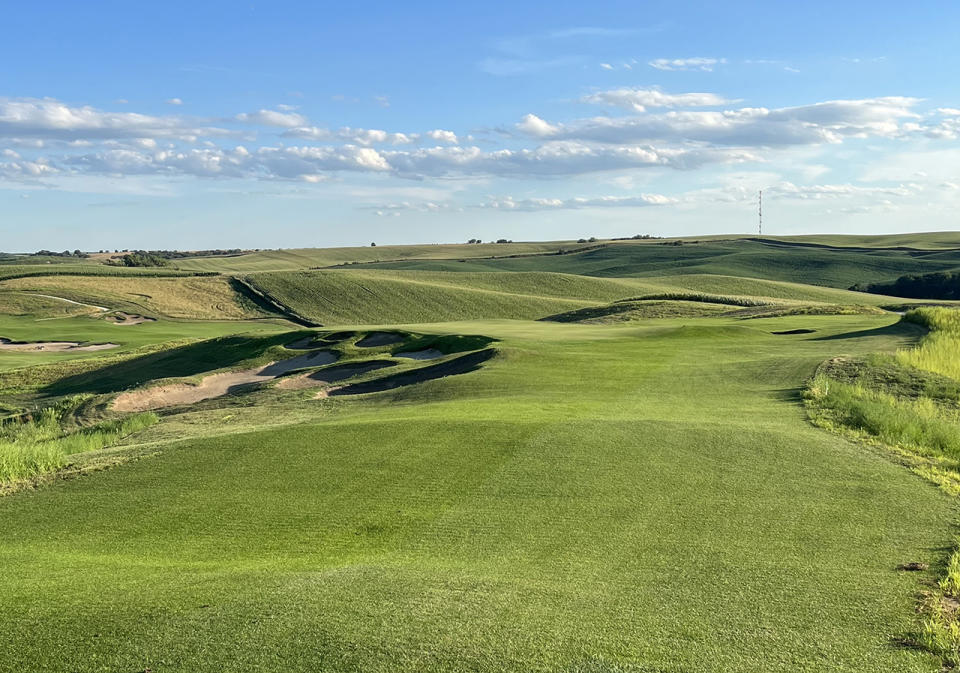‘Put the pedal down and go for it’: King-Collins’ Landmand Golf Club opens in Nebraska

Big and bold – good words to live by. Interesting, different, unlikely. All attributes ascribed to artists, authors, chefs, actors … really anyone who can grab attention and hold it.
Even golf course architects.
Rob Collins initially grabbed attention for his big and bold design at Sweetens Cove Golf Club which opened in 2015 in remote Tennessee. A nine-holer built on a flat floodplain amidst the Appalachian Mountains, Sweetens Cove had to grab attention and hold it – a run-of-the-mill design atop the previous course named Sequatchie Valley on the same damp site might have drawn flies, but not many golfers.
Instead, Collins and his design partner, Tad King, moved some 300,000 cubic yards of dirt to erect what has become Tennessee’s No. 1-ranked public-access course in Golfweek’s Best ratings. Big greens, bold slopes – there are those words again, and at Sweetens Cove, those concepts have drawn a loyal following of golfers who will drive to the middle of nowhere to experience something different and entirely interesting.
“I always did believe there was some form of greatness to be achieved out there, and that it could be very popular,” Collins said of Sweetens Cove, the first course built by his and King’s then-new golf architecture firm, King-Collins. “It was so different and so unique and so much fun, the early adopters of the place gave us so much enthusiasm and belief in what we had done. It was like a religious experience for a lot of people.”
Now comes the next step in big and bold for King-Collins, on a completely different landscape and scale – and after waiting longer than either could have imagined after Sweetens Cove’s ascent into the top 100 modern golf courses in the U.S.
The public-access Landmand Golf Club in eastern Nebraska, King-Collins’ first original 18-hole layout, opens for regular play September 3 on what Collins describes as simply crazy terrain for golf. Built atop and around bluffs and dunes near the village of Homer in the Loess Hills – geologic terrain left in the wake of retreating glaciers during the last Ice Age – Landmand presented unique challenges and opportunities in a wide-open and extreme landscape with views for miles. Collins said he and King went all-out in trying to take advantage of everything the site, including its 150 feet of elevation changes, offered.
An all-timer today @LandmandG – it’s impossible to express the amount of gratitude that Tad & I feel toward @wanders1140 & his great family for giving us this opportunity. It was a thrill from start to finish playing shots into features that so many labored over. pic.twitter.com/cujUBk2pQk
— King-Collins Golf (@KingCollinsGolf) August 31, 2022
“You had to just put the pedal down and go for it,” Collins said of his approach to Landmand. “The first time you see it, the scale is just going to blow your mind. Every time I go out there, I laugh about it. Things that are gigantic in reality just shrink in this landscape.”
On such a vast playing field – and because of the region’s frequent gusty winds – Collins said his team was inspired to install massive fairways, sometimes with one fairway corridor serving two holes. None of the fairways are less than 80 yards wide, several single fairways top out at more than 100 yards wide and the connecting fairways are stretched beyond 150 yards.
“A 60- or 70-yard-wide fairway just doesn’t cut it out there because it shrinks visually in the scale of that landscape,” Collins said. “And so, a 60-yard fairway would look 30 yards wide. You hit a ball out there and walk down into the fairway, you’re like, ‘My God, it’s gigantic, there’s no way I could have missed this fairway.’ You need features that are just that big out there.”

The green for the short par-4 17th as the grass grows in at Landmand Golf Club in Homer, Nebraska (Courtesy of Landmand Golf Club)
The greens at Landmand are similarly huge. Average greens at most U.S. courses are between 5,000 and 7,000 square feet – purely for example, Augusta National Golf Club’s greens average just over 6,400 square feet, while those at Pebble Beach Golf Links are tiny at about 3,500 square feet. At Landmand, King-Collins constructed putting surfaces that frequently blow past 20,000 square feet.
As a comparison for King-Collins fans, Collins said he receives frequent comments on the size of the fourth green at Sweetens Cove, an Alps-inspired putting surface stretching some 80 yards front to back. At Landmand, the fourth green from Sweetens would be only the fifth-largest putting surface.
Collins cites the par-3 fifth at Landmand as a great example of a large green fitting a big landscape. The approach from the back tee is some 240 yards across a chasm to a putting surface of more than 25,000 square feet.
“You look at it, and yeah it seems big, but then you get on it and realize it’s huge,” Collins said. “It has to be to fit. Standing on the tee, even a 12,000-square-foot green on top of that ridge would look stupid. It would look like a pimple on the ass of an elephant. It would look like we shied away from the landscape. We had to build features that embraced that boldness.”
It’s all part of the width and size serving strategy. Players shouldn’t just whack away and expect an easy next shot from a wide, forgiving fairway, especially if the wind blows. There’s skill to discerning the best route to any hole, Collins said, and golfers better think before they swing.
“Every shot on every golf course we ever do, we want to have a meaning behind it,” he said. “We don’t want any hole to take a shot off. We always want the golfer engaged. That may mean hazard placement, or in a lot of cases at a place like Landmand, it’s a big contour. … Each hole at Landmand was built to ask varying versions of some type of questions, and a lot of that is through contour.”
Elevation? In Nebraska?

No. 8 at Landmand Golf Club in Homer, Nebraska (Courtesy of Landmand Golf Club)
Those types of contours have drawn plenty of discerning golfers to Nebraska in recent decades. The No. 1 modern course in the U.S., as judged by Golfweek’s Best raters, is the Bill Coore/Ben Crenshaw-designed Sand Hills Golf Club some 230 miles west of Landmand in the Nebraska Sandhills, another geologic region where rumpled terrain has spurred the development of dozens of top courses, with more on the way.
“It might be the best golf state in the country,” said Collins, a native of Tennessee. “Nebraska certainly bucks the perception of it as a big flat cornfield. There couldn’t be anything further from the truth. Nebraska is a very hilly state, and the Sandhills region is famous.
“The area around Homer, where Landmand is, you could get lost on these cool little two-lane roads going through these little towns and up and over these hills. That big sky, that rolling landscape, it’s very cool. I fell in love with Nebraska and the beauty of it.”
That type of terrain also presented new challenges during construction. Unlike Sand Hills Golf Club – where Coore said he located more than 100 potentially great golf holes in waiting and just had to choose the best 18 for the routing – Landmand wasn’t an example of golf holes just lying there waiting to be exposed. Collins said his team moved more than 2 million cubic yards of dirt to establish reasonable playing corridors among the steep hills and ridges amid more than 500 acres of former farmland – landmand is a Danish word for farmer.
“The question that Landmand asked was the exact opposite of Sweetens Cove,” he said. “At Sweetens, we inherited a flat field with 1 foot of fall from one end to the other, and everything had to be pumped up to get it up high enough so the primary features weren’t going to spend weeks and weeks underwater during a flood and to create shotmaking interest.
“At Landmand, you have these extreme elevation changes, and we needed to take everything down to make it walkable and playable for golf because it was previously too severe. That was the goal at Landmand: moving the exact amount of dirt necessary to create a very natural-looking golf course that laid up and over and around these big ridges and hills. The goal with Landmand, and thanks to our crew we did it, was to disguise a lot of that. Most people who go out there won’t have any sense that that much dirt was moved. That is a testament to the skill of our crew.”
The result is what Collins predicts is the appearance of a lay-of-the-land course despite all the required shaping. And don’t expect it to play the same as Sweetens Cove.
“Every project is a form of a question, like a math problem,” Collins said. “Each one has a different way to answer it. Mine and Tad’s responsibility is, No. 1, find out what’s the question we’re being asked. And No. 2, find the best answer to that question. For each project, how do we get to that best answer?
“We always want to have artistic, interesting and unique features, and a flare to our style, but we don’t want to use the same pencil with every project. We want to expand our palate with every project.”
Breaking the glass ceiling

The 15th green with Nos. 16, 17 and 18 stretching beyond at Landmand Golf Club in Homer, Nebraska (Courtesy of Landmand Golf Club)
And finally, after years of waiting for the right calls, those projects are starting to roll in for King-Collins. Having completed several smaller renovations to existing facilities and having laid out another nine-hole course named Inness in New York, King-Collins recently renovated the municipal Overton Park Golf Course in Memphis and also has been busy building the private Red Feather in Texas, slated to open in 2023. Collins said he has several other projects in the works, some of which he can’t yet discuss publicly.
Many expected Sweetens Cove – of which King-Collins has become the owner and operator since it opened – to be an immediate springboard to even bigger projects. It didn’t work out that way, and Collins admits to suffering frustrations in those lean years as he pitched jobs that often went to more established designers.
“While it was difficult during those times, kind of waiting for the glass ceiling to crack open for us, I knew it would,” he said. “During that time, I felt like I developed a bit of a chip on my shoulder about it. I’m very competitive by nature and I believed so strongly in our team. That purgatory era has helped create a lot of drive and resolve within me personally, and I’m sure I could say the same thing about Tad. And I think ultimately that makes us better at our jobs because we are so driven and so focused and have a desire to lay down special and unique places. If it had come easily, maybe that knife wouldn’t be as sharp as it is right now. Maybe it was a good thing.
“I publicly said several times, we wanted the big one and we were sick of the big names being trotted out over and over. Landmand was our big one. I’m very confident in where King-Collins is going, and Tad knows where we’re going, and I don’t think there’s anything that can stop us.”
[listicle id=778272799]

